A delicious marmalade aroma spreads through my kitchen, mixed with notes of charred citrus. My hands are all sticky with the intense, jammy juice of kaipuli, the rough skinned, juicy bitter oranges beloved of Coorg home cooks, roasted on an open fire. I’ve just spent the better part of the morning preparing my annual supply of kaipuli chutte pajji, an unusual chutney of roasted bitter oranges. There’s so much work involved making this, but it’s work into which I throw myself willingly, in happy anticipation of the delicious results.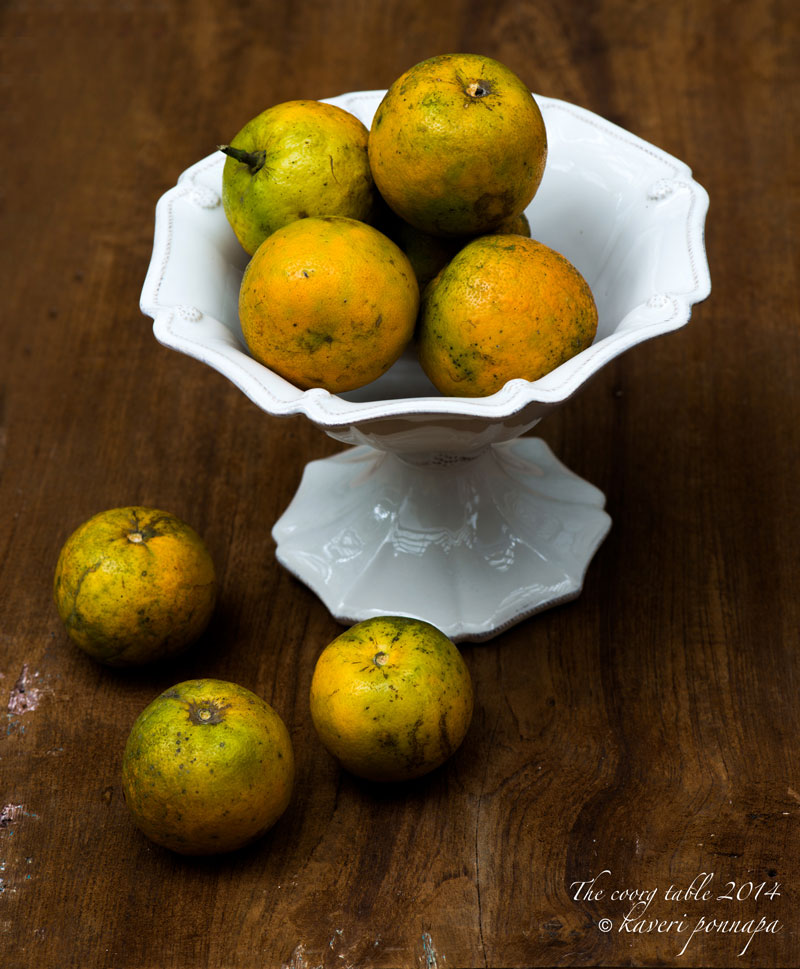
Kaipuli, the local bitter orange is the unsung beauty of the Coorg table®. When I hold one in my hand, I can never resist piercing the skin and breathing in the sharp, clean fragrance deeply. I’m reminded instantly of the quiet country lanes of Coorg, with their low, moss-covered walls overhung with trees, at the end of which you find isolated homes where you are always sure of a welcome. And whether it’s an ancestral home, or a small, cozy cottage, you can be sure, that if you wander around, you will find a kaipuli tree laden with fruit in season, waiting to be made into various treats. Kaipuli is a fruit of never ending pleasures, or so it seems, it’s sour juice and bitter flavours particularly cherished in Coorg. 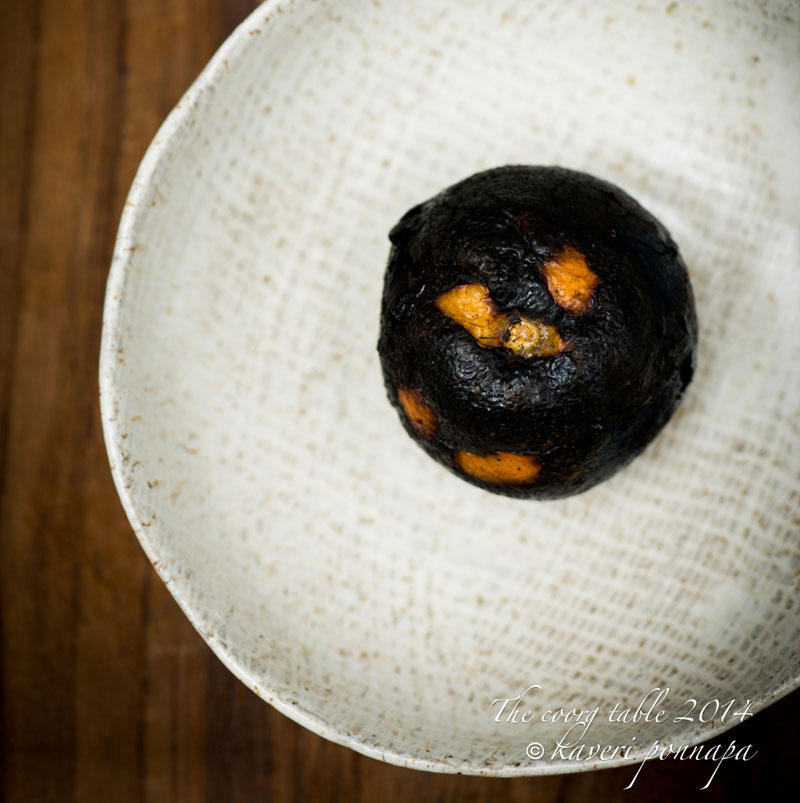
No luxury of a wood fire in the city here, but I do have a compact Weber grill, and red-hot coals deliver excellent results. Smoke clouds the patio outside my breakfast room. The thick, sometimes knobbly skin of the fruit darkens slowly on hot embers. Artistic patches of orange peer through the black, releasing aromatic oils that scent the air with the most beautiful fragrance. Occasionally, there’s a hiss and sizzle as a spray of juice shoots out of the roasting orange. The citrus scents all around send me straight to heaven. The skin will have to be well-scorched and blackened before the kaipuli is plunged into cold water. Then comes the painstaking part of peeling off the blackened exterior, and retaining the inner, darkened skin, which now has the most enticing, smoky aroma and will soon add a lovely texture to the chutney: tiny chunks that escape being ground into a pulp, with hints of marmalade. Like all char-grilled ingredients – think roasted tomatoes, onions, and peppers – there’s a distinctive smoky sweetness that seeps into the charred kaipuli. 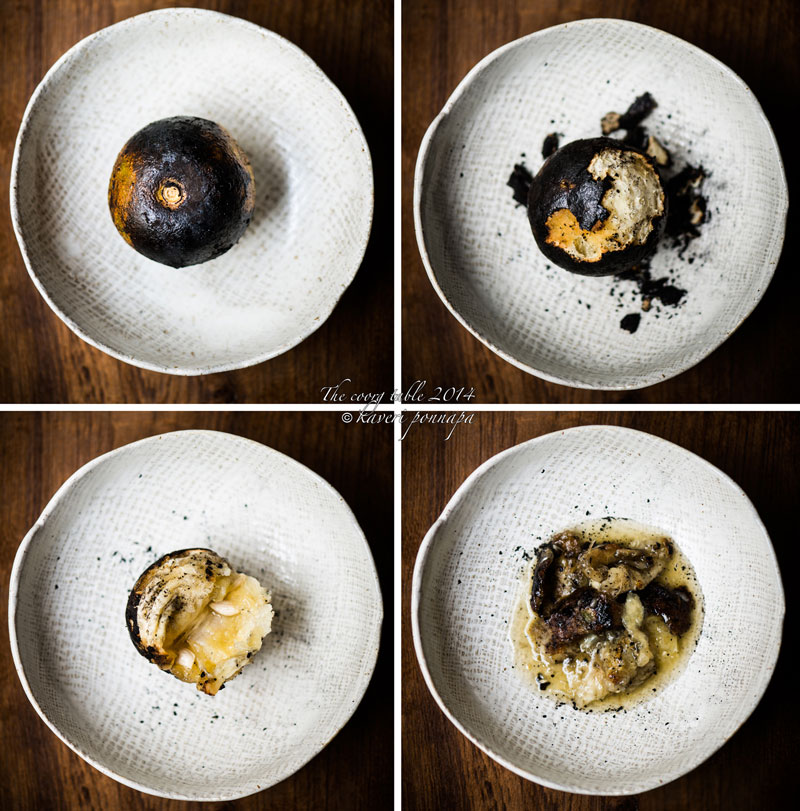
Separating the pulp from the thin membrane and slippery, never-ending seeds seems to take forever and by now, the bulk of several kaipulis has shrunk to a disconcertingly tiny puddle at the bottom of a bowl. The sour juice has wrinkled my fingertips until they look like they are a hundred years old!
It’s a long, patient morning’s worth of effort, but the thought of the dark chutney keeps me going. “What are you doing?” asks my daughter. “Oh nothing much,” I say casually, “just making a little chutney.” But she recognizes the tone instantly.
“When you say something in that innocent voice, I know it means trouble,” she replies. And she’s right. I rope in my husband to roast the kaipulis, and get her to help peel them when they are done.
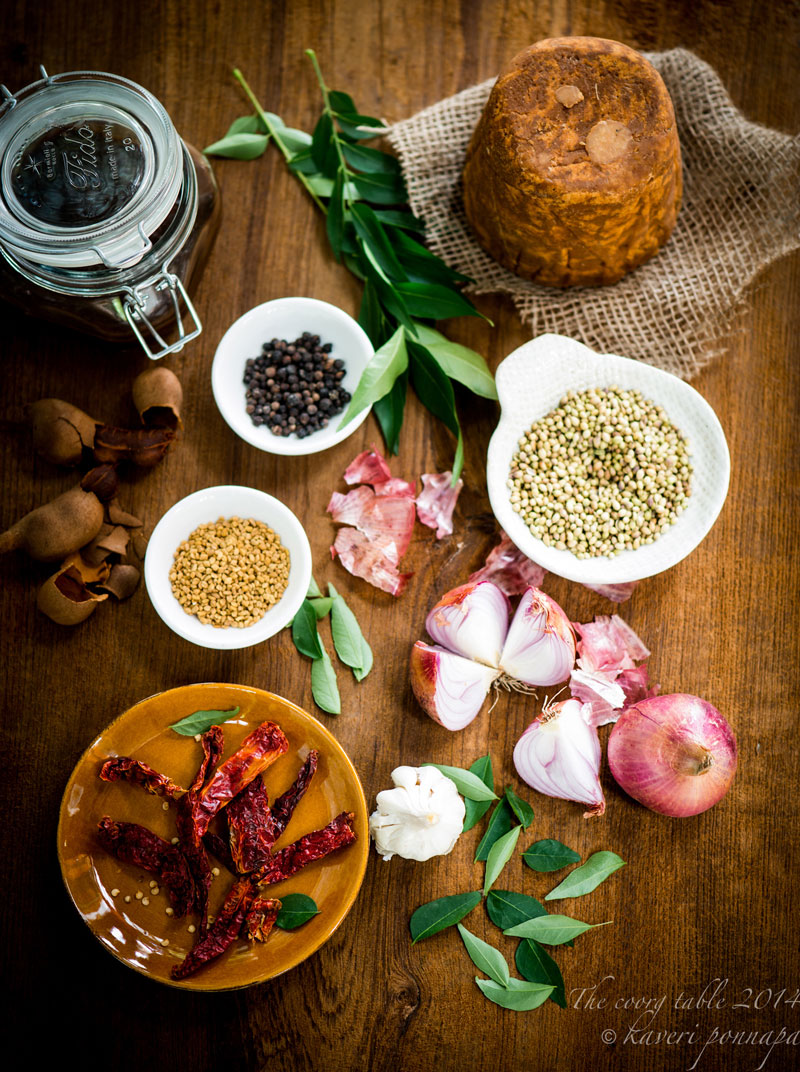 Kaipuli chutte pajji is an acquired taste, but those who love it – and I’m on top of that list here – love it devotedly. It is one of those unique Coorg flavours difficult to describe. Every time I make it, I can only marvel at the imagination, patience and experience of the home cooks who created and developed this recipe. The bottled chutney is a rich, dark brown, shiny, bittersweet, and warm with spice. Its jam-like texture and smoky flavour stir up memories of wood fired kitchens, rain and newborn babies. Babies because this dark, dense chutney that has many cleansing and curative properties is also known as petthavvada pajji -chutney for new mothers –and it’s always on the menu for them, every day.
Kaipuli chutte pajji is an acquired taste, but those who love it – and I’m on top of that list here – love it devotedly. It is one of those unique Coorg flavours difficult to describe. Every time I make it, I can only marvel at the imagination, patience and experience of the home cooks who created and developed this recipe. The bottled chutney is a rich, dark brown, shiny, bittersweet, and warm with spice. Its jam-like texture and smoky flavour stir up memories of wood fired kitchens, rain and newborn babies. Babies because this dark, dense chutney that has many cleansing and curative properties is also known as petthavvada pajji -chutney for new mothers –and it’s always on the menu for them, every day. 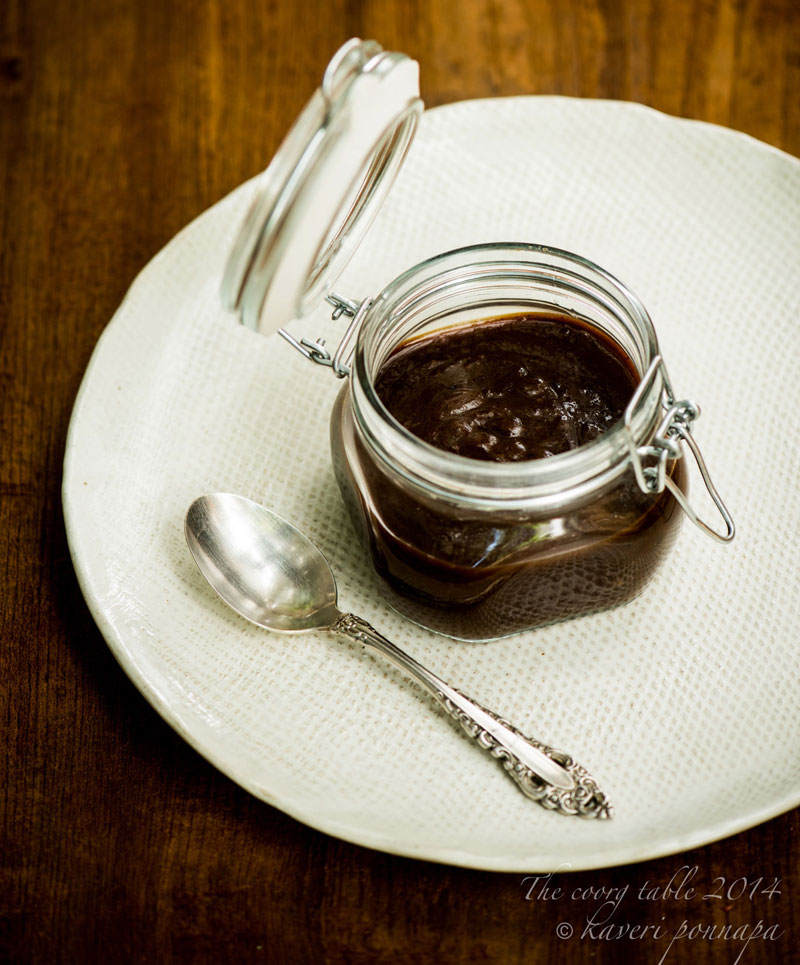 It’s hard to make up your mind about exactly what this is: traditionally, it’s a pajji, a chutney in which the ingredients are ground together. But it has the texture of a soft-set jam, and can be eaten with so many different accompaniments. Some days I love to make a lunch of just a plateful of soft, white, short-grain rice, curd and a large scoop of kaipuli chutte pajji. The flavours are full of intriguing layers of fried onions, coriander seeds, chillies, cumin and jaggery, and a lingering taste of citrus that refreshes the most jaded palate. It tastes equally good as part of a simple main meal; with akki ottis or, as one of my aunts recommends, on toast.
It’s hard to make up your mind about exactly what this is: traditionally, it’s a pajji, a chutney in which the ingredients are ground together. But it has the texture of a soft-set jam, and can be eaten with so many different accompaniments. Some days I love to make a lunch of just a plateful of soft, white, short-grain rice, curd and a large scoop of kaipuli chutte pajji. The flavours are full of intriguing layers of fried onions, coriander seeds, chillies, cumin and jaggery, and a lingering taste of citrus that refreshes the most jaded palate. It tastes equally good as part of a simple main meal; with akki ottis or, as one of my aunts recommends, on toast. 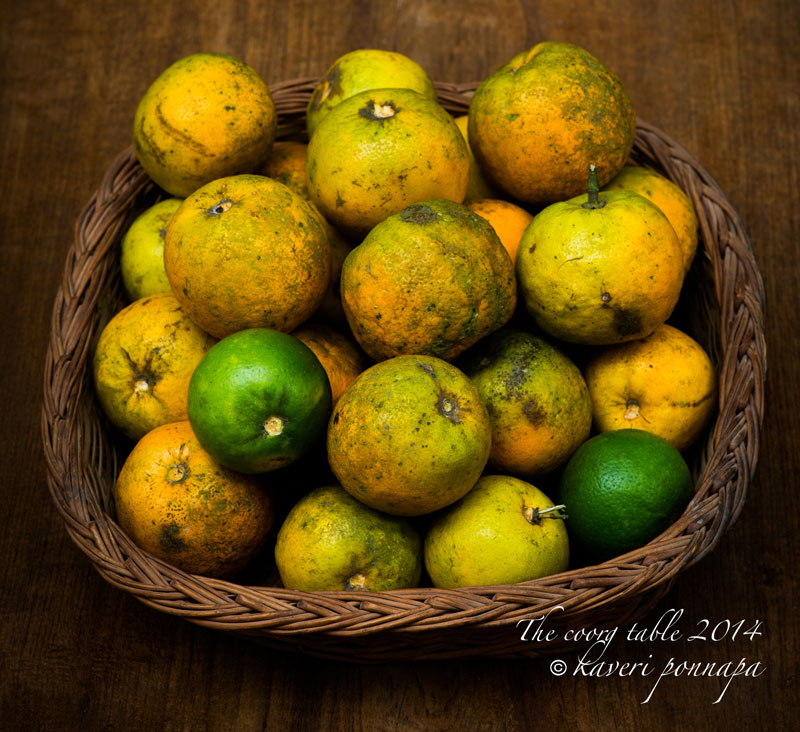 My mother-in-law would always send me off with a huge bottle of the stuff, carefully packed to survive its journey to London, where I tried make it last as long as possible, for a lingering taste of home. My enthusiasm rubbed off on my husband, never much of a fan, who soon acquired a taste for it, and is now as fond of it as I always was. Our son loves it, while our daughter says, enigmatically, that she’s ‘developing a taste for it,’ although I don’t see her eating much of it. Surprisingly – or maybe not so – this is one of the local treats that a lot of visitors to Coorg like to buy from stores that sell home made pickles and jams, to carry back with them.
My mother-in-law would always send me off with a huge bottle of the stuff, carefully packed to survive its journey to London, where I tried make it last as long as possible, for a lingering taste of home. My enthusiasm rubbed off on my husband, never much of a fan, who soon acquired a taste for it, and is now as fond of it as I always was. Our son loves it, while our daughter says, enigmatically, that she’s ‘developing a taste for it,’ although I don’t see her eating much of it. Surprisingly – or maybe not so – this is one of the local treats that a lot of visitors to Coorg like to buy from stores that sell home made pickles and jams, to carry back with them. 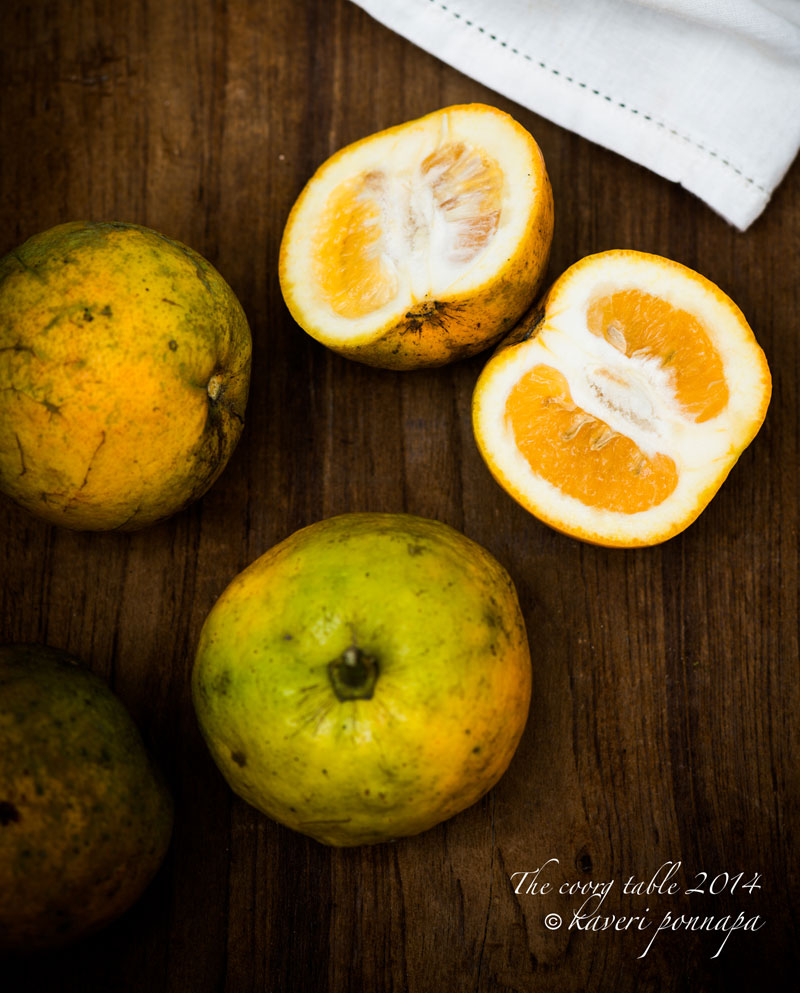
After an entire morning of roasting, peeling, frying, grinding and boiling, surrounded by an incredible mess of charred skin, discarded seeds and membrane – not to mention blackened, ruined, fingernails – my daughter stared at the single, 750 ml jar of chutney and asked, incredulous, “Is that all?” Yes, it was, actually. There’s no way you can explain what makes all the effort worthwhile until you plunge a spoon into the dark, silky mass, put a helping onto your plate and taste those complex, bittersweet, citrus fruit flavours with just the right hint of spice. A few weeks ago, I read that burning citrus fruits is the current craze with many professional chefs worldwide, to highlight sweet and bitter flavours, and reduce acidity. Stuff our grandmothers have worked out so well in this unique chutney, so evocative of the Coorg countryside and way of life.
Note : Kaipuli, literally translates as ‘bitter orange’ and goes under the label of Citrus aurantium.
Thank you for visiting this page. If you read something that you enjoy, or see an image that you like, please take a moment to write a response. Do look out for the recipes of all the food featured here in my upcoming cookbook.

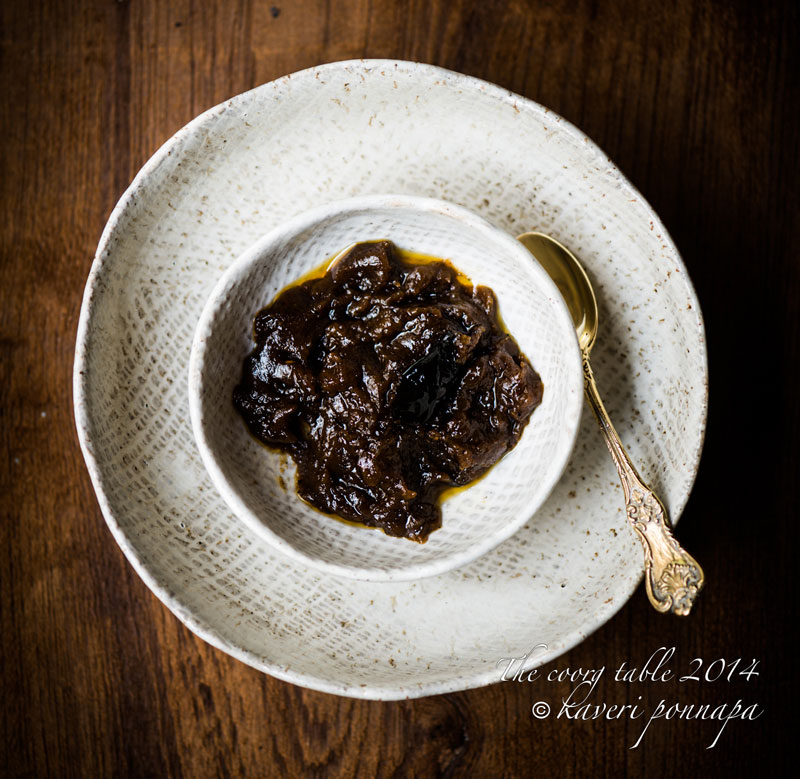



Dear Kaveri,
Been following your lovely page and website. Would love to know the health benefits of kaipuli. Being a kodavathi who has always lived and studied outside of coorg, it would be quite informative.
Thankyou!
Regards,
Kajal.
Hello Kajal, thank you for reading, and enjoying the website. Other than the fact that we love kaipuli just for itself in so many forms it is full of vitamin C, and highly valued for its digestive properties as burnt kaipuli pajji. There are numerous scientific studies that list its antioxidant, antibacterial, anti-diabetic and many other beneficial components including vitamins, minerals and flavanoids. So the list is long, and again, it’s quite fascinating to think of how this fruit always was such an important part of our food.Do keep reading! Warm wishes, Kaveri
What an awsome write up about my favourite dish in the whole wide world.! Came across ur recipe while I was browsing for the exact same thing! Cant thank you enough!! I cant get kaipuli where I live.. wondered if any other sort of lemon would do any justice to ur great recipe?
Hi Shirly, thank you for your kind words about this post. I’m not surprised this is such a favourite with you. A helping of kaipuli pajji makes the whole meal perfect for me. I’m not sure where you are located, but bitter Seville oranges, used to make marmalade should be a reasonable substitute. They are fairly similar. Perhaps you could try a batch of 2-3 and see how they work. Good luck! Kaveri
I loved reading this!Made me smile:)Your writing is so beautiful and poignant.I have a whole basketful of kaipuli lying around, and I was scouting the net trying to find a scorched kaipuli recipe different from what I normally make, and I stumbled upon your beautiful page.And I just HAD to drop a note to say how much I enjoyed reading this:)
Hello Shwetha, welcome to The Coorg Table. Thank you for having taken the time to write, I’m so glad that you enjoyed this post. How wonderful to have an entire basketful of kaipulis to work with! The last few years have not been so good for this best of citrus fruits, what with the erratic weather patterns. Many people across Coorg have told me about harvesting either water-logged fruit, or rather dehydrated ones. I have just finished making a few bottles from a lucky batch myself- enjoy that basketful! Kaveri
Hi,
This sounds/looks rather interesting! Thank you for sharing this recipe. I’m going to try this but could you please suggest… what does it taste best with?
Hi Inara, this is an absolutely delicious chutney. You can eat it with just about anything you like. It can be an accompaniment to a main meal of rice and curry, or rice and pepper water. It goes well with akki ottis (rice rotis), chappatis or even bread. My personal favourite is eating it with curd and rice, as the plain taste of this combination sets off the lovely, complex flavours of Kaipuli pajji. Enjoy the chutney! Best wishes,Kaveri
What a lovely story! So evocative and steeped in memories of times gone by! What one will do for love — even spend hours peeling and grinding!
For love of burnt bitter orange chutney it was! Delighted you liked the post, will try and get some across to you – or another visit due? xo
I can almost taste this recipe Kaveri. I love the photography. And yes, removing the skin does seem tedious. I now have to find a Coorg friend who will make this for me…as a labour of love.
Hello Aparna, welcome to The Coorg Table, and thanks very much for you response. I’m delighted that you like the images, because while this chutney is most delicious, it’s also the most un-photogenic dish! I am sure one of your Coorg friends would be only too happy to make you a bottle of chutney, and it will last you a good, long time. Enjoy your kaipuli chutte pajji! Warm wishes, Kaveri
Very well written about the kaipuli from Coorg. Kudos to the author.
The kaipuli chutta chutney is loved by everyone at our home as well.
Hello Deepa, thanks for visiting The Coorg Table. I’m glad you liked the article, and it’s nice to know that everyone in your family loves kaipuli chutte pajji, it really is one of the best creations from our traditional kitchens.I’m sure you have your year’s supply ready, too! Warm wishes,Kaveri.
What a co-incidence, my mom has prepared it today for dinner, but with a little change with little cloves and cinnamon and no onion and also without burning bitter oranges. Next time while preparing will burn it and try how it tastes differently. Thank you!!
Hi Kaverappa, I’m sure the chutney that your mother makes is very good, it’s sounds great! I would love to know what she used, as every family has a slightly different way of making the same dishes, and it’s always interesting to learn something new. Best wishes, Kaveri.
What a lovely story to your burnt orange chutney Kaveri. I can imagine you roasting the oranges then lovingly preparing this timeless delicacy so dear to your community. I hope I get to taste it sometime. God bless you in all your endeavours to keep the flavours of your community’s cuisine alive.
I’m so glad you liked this story, Bridget, especially since the chutney is an all-time favourite of mine. Thanks so much for your good wishes and appreciation – this blog is a labour of love,as I feel our traditional cuisine has so much to offer and it’s wonderful when people write in with their impressions. And I’ll make sure that you get to taste kaipuli chutte pajji very soon! Warm wishes. Kaveri.